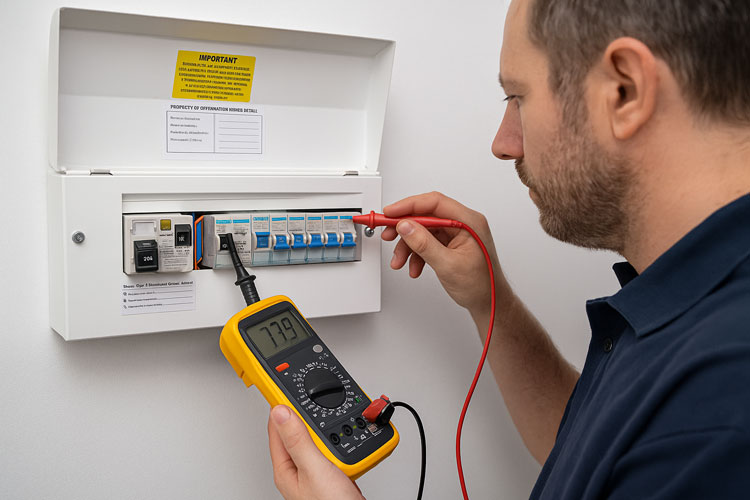EICR Regulation Changes: What Landlords Need to Know from November 2025
Published on September 30, 2025 by Sarah Mac

Electrical safety is one of the biggest responsibilities a landlord faces. Since 2020, all private rented sector (PRS) landlords have been required to carry out regular Electrical Installation Condition Reports (EICRs) to prove their properties are safe for tenants.
But from November 2025, those rules are changing. The government has announced the biggest shake-up to electrical compliance in rental housing since the current laws were introduced. For landlords, that means new obligations, tighter deadlines, and greater accountability.
Here’s what’s changing, why it matters, and what steps you should be taking now.
What is an EICR?
An Electrical Installation Condition Report (EICR) is a professional inspection of a property’s fixed electrical systems. Unlike PAT testing, which looks at portable appliances, an EICR examines the permanent infrastructure — wiring, sockets, fuse boards, protective devices and circuits.
The purpose is to identify deterioration, defects or hazards, and to confirm that the installation meets current safety standards. Any faults are graded using a coding system, from urgent remedial action to suggested improvements.
For landlords, an EICR is both a legal requirement and a safeguard. It helps prevent electrical fires or shocks and provides evidence of due diligence if issues arise.
The current rules
Since the Electrical Safety Standards in the Private Rented Sector (England) Regulations 2020, landlords must:
- Obtain an EICR at least every five years, or at a change of tenancy.
- Use a qualified, competent contractor to carry out the inspection.
- Provide a copy of the report to tenants and local authorities on request.
- Complete any remedial work identified, usually within 28 days.
Non-compliance can result in civil penalties of up to £30,000, not to mention reputational and insurance risks.
What’s changing in November 2025?
The new updates take effect for new tenancies from November 2025, with a short grace period for existing lets. They mark a shift towards more proactive, standardised compliance.
Key changes include:
- Inspection frequency: High-risk housing — including HMOs, older buildings and some converted properties — will require more frequent checks than the standard five years.
- Expanded scope: Inspectors will assess additional elements such as modern protective devices, surge protection, and signs of tampering or DIY electrical work.
- Standardised coding: Observations will follow a national coding system, ensuring consistency across contractors and reducing ambiguity.
- Tenant notification: Landlords will need to provide tenants with copies of the EICR report within a tighter timeframe.
- Enforcement: Local authorities are being given stronger powers to fine landlords, demand remedial work, and penalise repeat offenders.
Why are the changes happening?
The government’s stated aims are straightforward:
- Improve tenant safety – electrical faults remain one of the top causes of fires in UK homes.
- Standardise compliance – ensuring landlords and inspectors are all working to the same definitions and standards.
- Close loopholes – past incidents have shown weaknesses in the current system.
- Raise housing standards – keeping pace with modern housing needs and electrical technology.
In short, the reforms are about reducing risk and ensuring consistent protection across the private rented sector.
What do the changes mean for landlords?
For landlords, the changes mean a step up in both responsibility and administration.
- More planning: With shorter inspection intervals in some cases, landlords will need to schedule checks more carefully, especially across large portfolios.
- Extra paperwork: Keeping copies of reports, providing them promptly to tenants, and documenting remedial work will be vital.
- Budget impact: More frequent inspections and potential remedial work mean higher costs, so budgeting ahead is crucial.
- Greater accountability: Obtaining the report is no longer enough. If faults are found, you’ll be expected to show they were resolved quickly and properly.
For professional landlords, this is a compliance exercise. For accidental landlords with one or two properties, it may feel like a burden — but the risks of ignoring the rules are simply too high.
How to prepare for the November 2025 EICR changes?
There’s still time to get ahead. Landlords should:
- Review current records: Audit your existing EICRs. Check when they were last done, what faults were noted, and whether remedial work was completed.
- Book early: Don’t leave inspections until the deadline. Accredited contractors are likely to be in high demand once the changes take effect.
- Choose qualified inspectors: Always use NICEIC-approved or equivalent contractors to avoid invalid reports.
- Stay organised: Store reports digitally, so they’re easy to access and share.
- Budget for remedial works: Set aside funds now — it’s better than scrambling later when urgent safety fixes are required.
How can SRP Inventories help?
While SRP Inventories doesn’t carry out EICRs, our work supports landlords in meeting their compliance obligations.
Through mid-term inspections, detailed reports, and regular property visits, we provide an extra layer of oversight, helping you spot potential issues early and maintain proper documentation.
With regulations tightening, having reliable, independent records of your property’s condition has never been more important.
EICR changes 2025 – final thoughts
The November 2025 EICR regulation changes represent the most significant shift in landlord electrical safety rules for five years. The goal is clear: safer homes, fewer grey areas, and higher standards across the private rented sector.
For landlords, this means more frequent checks, stricter deadlines, and stronger enforcement. But with preparation, planning and the right support, compliance doesn’t have to be stressful.
By staying organised and proactive now, you’ll save yourself time, money, and potential penalties later.
Need support with your property inspections? SRP Inventories is here to help landlords stay compliant with confidence. Get in touch today to find out how simple – and beneficial – it is to switch your inventories to SRP.

